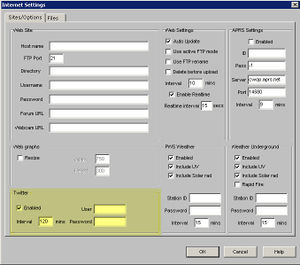Twitter.txt
Cumulus has the ability to tweet weather updates to the Twitter service at regular intervals. Twitter users would then subscribe to your Twitter page and have your weather updates pushed to them.
In order to configure Cumulus you must first create an account on Twitter.
To setup Cumulus, click Configure, Internet and look in the 'Sites/Options' tab. Tick the Enabled option, type user Twitter username and password and select how often you wish to send the updates to Twitter. The Interval figure is 'minutes'. Cumulus will now start tweeting; this may take some time to start (depending on your interval figure) so you many not see instant results on twitter.
Twitter support was added in Version 1.8.5 however due to security changes with the Twitter service you MUST be running version 1.9.0 or above of Cumulus
There is also a list of Cumulus Twitter Usernames
How to configure what is sent
By default Cumulus will tweet the following information:
- Wind speed and direction
- Pressure and trend
- Temperature
- Rain Today
- Humidity
A default 'tweet' could read.... "Wind 8 mph W. Barometer 1036.81 mb, Rising slowly. Temperature 6.3 °C. Rain today 0.4 mm. Humidity 78%"
You can change what information is sent to Twitter. Create a text file called twitter.txt and save it in your Cumulus program folder. The file may contain static text and any combination of Cumulus webtags. Cumulus will read the file, process any web tags in it, and use the result to update Twitter.
Note:
- Twitter messages can not be more that 140 characters so bear this in mind when building your message.
- If you try to put 'accented' characters into the file, the Twitter update will probably fail
- Take into account the maximum length of any webtag; pay close attention to the <#forecast> webtag if you use it as some of the text generated by it can be long. If your eventual tweet is over 140 character it will be truncated by Cumulus.
- If you want to include any Twitter 'hash tags' in your message, just add them as plain text, e.g. #hashtag
An example of a twitter.txt:
Temp: <#temp>°C Wind:<#wspeed>mph Pressure: <#press>hpa <#presstrend> Rain Today <#rfall>mm. Forecast: <#forecast>
The equivalent of the default 'tweet' as a twitter.txt file is as follows:
Wind <#wspeed> <#windunit> <#wdir>. Barometer <#press> <#pressunit>, <#presstrend>. Temperature <#temp> <#tempunit>. Rain today <#rfall> <#rainunit>. Humidity <#hum>%
You might find the degree symbol from <#tempunit> is displayed by Twitter as ° in which case the simple solution is to 'hard code' your temperature units in the twitter.txt file rather than using the web tag.
